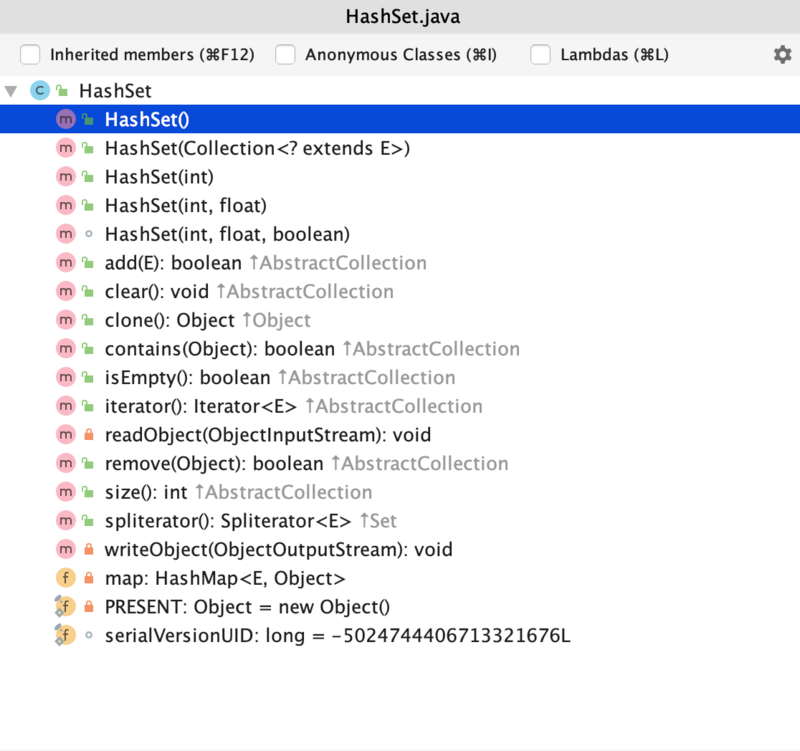Hashset源码分析
1. 概述
Hashset 实现 set 接口,底层基于 Hashmap 实现, 但与 Hashmap 不同的实 Hashmap 存储键值对,Hashset 仅存储对象。
HashSet 使用成员对象来计算 hashcode 值。
2. 原理
在《Head fist java》一书中有描述:
当你把对象加入 HashSet 时,HashSet 会先计算对象的 hashcode 值来判断对象加入的位置,同时也会与其他加入的对象的 hashcode 值作比较,如果没有相符的 hashcode,HashSet 会假设对象没有重复出现。但是如果发现有相同 hashcode 值的对象,这时会调用 equals()方法来检查 hashcode 相等的对象是否真的相同。如果两者相同,则覆盖旧元素。
这里看到很多文章说:
。根据 hashmap 的 put()方法源码可知,实际上是覆盖操作,虽然覆盖对象的 key 和 value 都完全一致。
hashCode()与 equals()的相关规定:
- 如果两个对象相等,则 hashcode 一定也是相同的
- 两个对象相等,对两个 equals 方法返回 true
- 两个对象有相同的 hashcode 值,它们也不一定是相等的
- 综上,equals 方法被覆盖过,则 hashCode 方法也必须被覆盖
- hashCode()的默认行为是对堆上的对象产生独特值。如果没有重写 hashCode(),则该 class 的两个对象无论如何都不会相等(即使这两个对象指向相同的数据)。
==与 equals 的区别
- ==是判断两个变量或实例是不是指向同一个内存空间 equals 是判断两个变量或实例所指向的内存空间的值是不是相同
- ==是指对内存地址进行比较 equals()是对字符串的内容进行比较
- ==指引用是否相同 equals()指的是值是否相同
3. 源码分析
首先查看下源码结构,发现该类源码相对比较简单

3.1 构造方法
/**
* Constructs a new, empty set; the backing <tt>HashMap</tt> instance has
* default initial capacity (16) and load factor (0.75).
*/
// 内部存储在hashmap中
public HashSet() {
map = new HashMap<>();
}
3.2 添加元素 add()
private static final Object PRESENT = new Object();
public boolean add(E e) {
return map.put(e, PRESENT)==null;
}
可以看到添加的对象直接作为 Hashmap 的 key, 而 value 是 final 修饰的空对象。
根据之前对 Java 面试必问之 Hashmap 底层实现原理(JDK1.8) 中 put() 方法的解读可以知道:
在 Hashmap 中首先根据 hashCode 寻找数组 bucket,当 hash 冲突时,需要比较 key 是否相等,相等则覆盖,否则通过拉链法进行处理。在 Hashset 中存储的对象作为 key,所以存储对象需要重写 hashCode() 和 equals() 方法。
4. 使用案例分析
4.1 存储字符串案例
再来看一组示例
public class Demo2 {
public static void main(String[] args) {
HashSet<Object> hashSet = new HashSet<>();
hashSet.add("a");
hashSet.add("b");
hashSet.add("c");
hashSet.add("a");
System.out.println(hashSet);
}
}
结果
[a, b, c]
分析
查看字符串源码.字符串重写了 hashCode()和 equals 方法, 所以结果符合预期
public int hashCode() {
int h = hash;
if (h == 0 && value.length > 0) {
char val[] = value;
for (int i = 0; i < value.length; i++) {
h = 31 * h + val[i];
}
hash = h;
}
return h;
}
public boolean equals(Object anObject) {
if (this == anObject) {
return true;
}
if (anObject instanceof String) {
String anotherString = (String)anObject;
int n = value.length;
if (n == anotherString.value.length) {
char v1[] = value;
char v2[] = anotherString.value;
int i = 0;
while (n-- != 0) {
if (v1[i] != v2[i])
return false;
i++;
}
return true;
}
}
return false;
} }
4.2 存储对象错误案例
首先我们创建一个 user 对象
@Getter@Setter
@AllArgsConstructor
@ToString
public class User {
private String username;
}
根据 set 集合的属性,set 中的元素是不重复的,现在测试下
public class Demo {
public static void main(String[] args) {
HashSet<Object> hashSet = new HashSet<>();
hashSet.add(new User("a"));
hashSet.add(new User("b"));
hashSet.add(new User("c"));
hashSet.add(new User("a"));
System.out.println(hashSet);
}
}
结果输出
[User(username=a), User(username=c), User(username=b), User(username=a)]
怎么会有重复的呢? 和预期结果不符呀。其实根据上边的源码我们已经知道原因了,打印 hash 值确认下
[901506536, 1513712028, 747464370, 1018547642]
java 中对象默认继承顶级父类 Object。在 Object 类中源码如下:
public native int hashCode();
// 比较内存地址
public boolean equals(Object obj) {
return (this == obj);
}
4.3 存储对象正确示范
重写 equals()和 hashCode()方法。(这里偷了个懒,感兴趣的大家可以自己重写下这 2 个方法)
@Getter@Setter
@AllArgsConstructor
@ToString
@EqualsAndHashCode
public class User extends Object{
private String username;
}
再次输出发现结果唯一了
[User(username=a), User(username=b), User(username=c)]
5. 总结
其实 HashSet 的一些东西都是用 HashMap 来实现的,如果 HashMap 的源码已经阅读过的话基本上没有什么问题。这可能是我写的最轻松的一篇文章。











![[HBLOG]公众号](https://www.liuhaihua.cn/img/qrcode_gzh.jpg)

